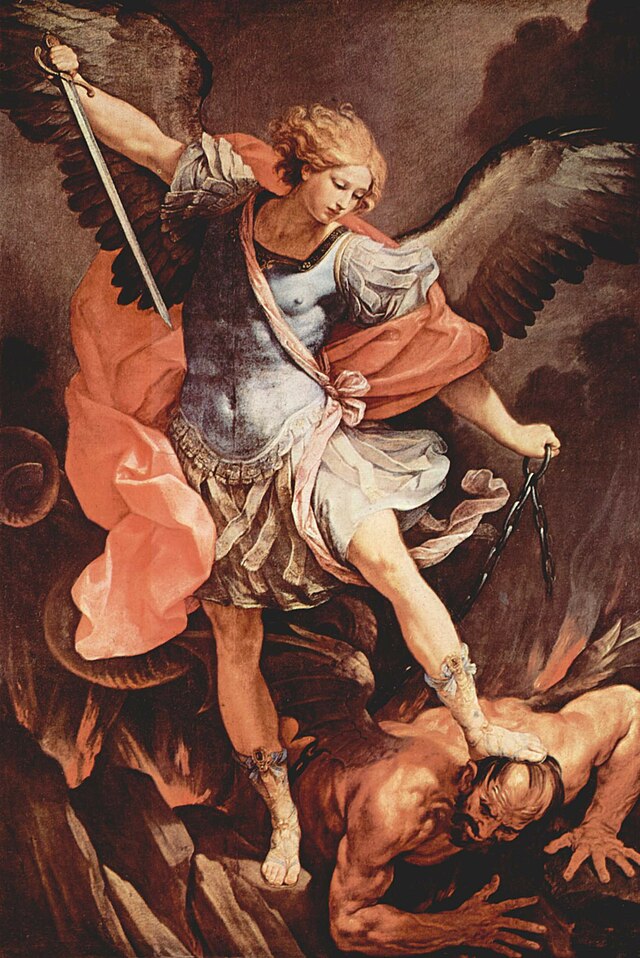
St. Michael, “reaching out to souls in purgatory…”
March 11, 2015 – Back on August 10th I did a post on St. Michael and All Angels. It was about an Episcopal church – “Saint Michael and All Angels” – that Mi Dulce and I passed on the way out of Stone Mountain. (That’s a park east of Atlanta.)
Which led to a question, “Who the heck is this St. Michael guy?”
There’s more on St. Michael below. But first let me say that last Sunday, March 8, “we” attended the 11:00 a.m. service at St. Michael Catholic Church on Tybee Island. (An island on the coast of Georgia east of Savannah. The Episcopal Church around the corner had a service at 10:00 a.m., but that was actually 9:00 thanks to the time change, so it was way too early…)
The sanctuary itself was nice and cozy, and the Bible readings were the same as those described in The “Big Ten” and Jesus with a whip. That is, “Exodus 20:1-17, Psalm 19, 1 Corinthians 1:18-25, and John 2:13-22. For the full readings see the Third Sunday in Lent.” (The Catholic Church and Episcopal Church share the same Revised Common Lectionary.)
St. Michael’s has been on Tybee since July 5, 1891, as noted in the Morning News:
Tybee’s Roman Catholic chapel was dedicated yesterday morning (July 5, 1891) by Bishop Thomas A. Becker… Bishop Becker named the chapel after St. Michael the Archangel, who is known as the rule[r] of the waves. The name is peculiarly appropriate on account of the chapel being at the seaside. The 9:30 o’clock train carried down about 200 people to attend the services, and they, together with Tybee residents, filled the little church to overflowing.
See St. Michael, under “About Us” and the parish history. The history noted that the church on the beach cost the then-whopping sum of $2,000 to build.
Now, about Tybee Island. It’s a small island and a small city east of Savannah, and the easternmost point in the state of Georgia. Long known as a “quiet getaway for the residents of Savannah,” it has recently become equally popular for other tourists as well:
It is one of the few locations where the U.S. Air Force dropped an atomic bomb – by accident (during a botched 1958 military training exercise). Though the “Tybee Bomb” did not detonate … there has been ongoing concern, since the Mark 15 nuclear bomb lost during the mishap was never found… [On a lighter note,] Tybee Island has had an annual Beach Bum parade … down the main road in Tybee, Butler Avenue, and when parade floats come by onlookers have been known to shoot each other with water-guns.
See Wikipedia, the free encyclopedia. There’s also The Breakfast Club, a “legendary” way to start a bright Sunday morning, before going to mass at St. Michael’s. (Just be sure to get there before the line starts forming outside the front door.)
But we digress…
For more about the original St. Michael, see the Book of Revelation at 12:7-10:
[T]here was war in heaven: Michael and his angels fought against the dragon; and the dragon fought and his angels. And prevailed not… [T]he great dragon was cast out, that old serpent, called the Devil, and Satan, which deceiveth the whole world; he was cast out into the earth, and his angels were cast out with him. And I heard a loud voice saying … the accuser of our brethren is cast down, which accused them before our God day and night.
Note that both the Hebrew and Greek words “Satan” (“Satanas” in Greek) translate as “an adversary,” while the root word for devil is “diabolos,” which is Greek for “slanderer.”
Or see Michael (archangel) – Wikipedia, the free encyclopedia, which included this:
Michael ([which translates] “who is like God?” … ) is an archangel in Jewish, Christian, and Islamic teachings. Roman Catholics, the Eastern Orthodox, Anglicans, and Lutherans refer to him as “Saint Michael the Archangel” and also as “Saint Michael. . .” In the New Testament Michael leads God’s armies against Satan‘s forces in the Book of Revelation, where during the war in heaven he defeats Satan.
Also, St. Michael has a Feast Day – called Michaelmas Day – on September 29.
I’ve included two images of St. Michael. The one below shows him “trampling Satan.” The upper image shows him in another of his jobs, “reaching out to souls in purgatory.” That means he might end up being the archangel who saves my own spiritual butt.
On the other hand, there is that part of the Book of Common Prayer which calls the idea a “Romish doctrine.” But for myself I say, “Hey, I’ll take all the help I can get!”

The upper image is courtesy of the Wikipedia article on St. Michael. The full caption: “Archangel Michael reaching to save souls in purgatory, by Jacopo Vignali, 17th century.”
Dulce is Spanish for “Sweet,” or in the alternative Mi Dulce or “My Sweet.” (See also the posts On “St. James the Greater”, and On the “Infinite Frog.”)
As to the definitions of Satan and/or the “Slanderer,” see the New International Dictionary of the Bible, Regency Reference Library, 1987, Page 899.
Re: “shared lectionary.” Wikipedia noted, “This lectionary was derived from various Protestant lectionaries in current use, which in turn were based on the 1969 Ordo Lectionum Missae, a three-year lectionary produced by the Roman Catholic Church following the reforms of the Second Vatican Council.”
The lower image is also courtesy of the Wikipedia article, with the full caption: “Guido Reni‘s painting in Santa Maria della Concezione, Rome, 1636 is also reproduced in mosaic at the St. Michael Altar in St. Peter’s Basilica, in the Vatican.”
For more information, see the notes for On “St. Michael and All Angels.”